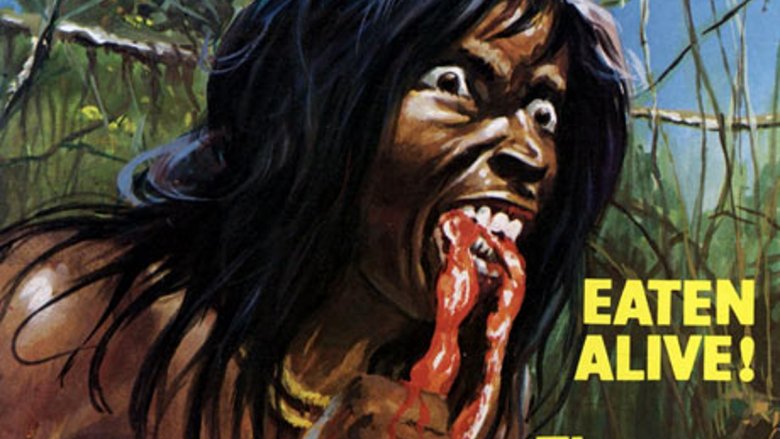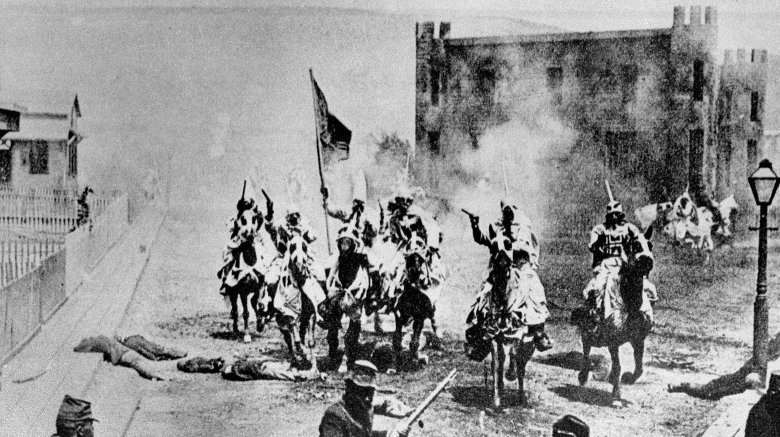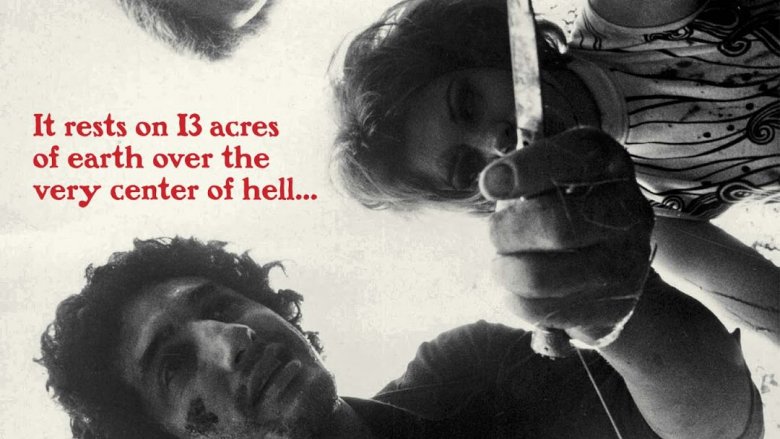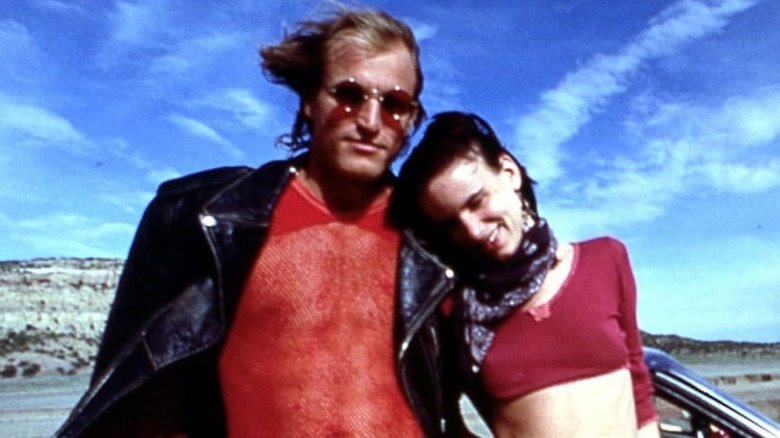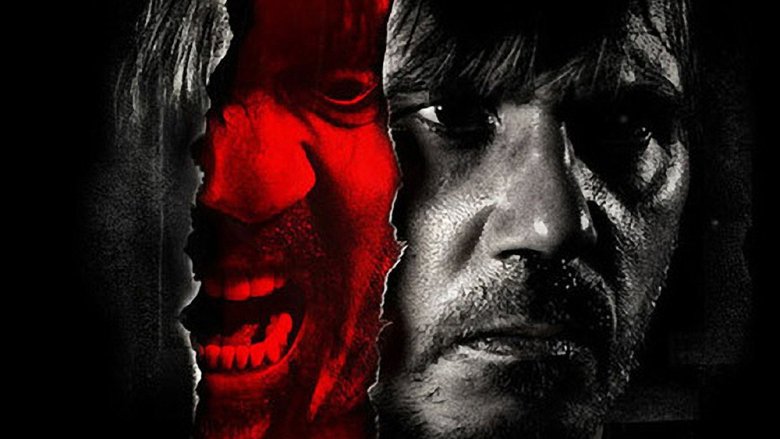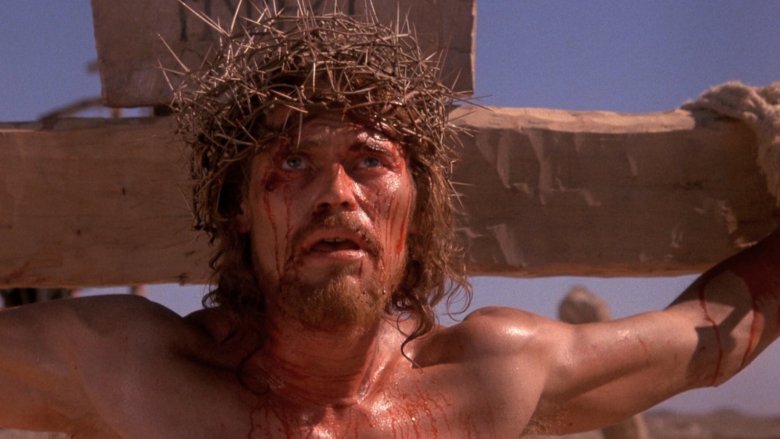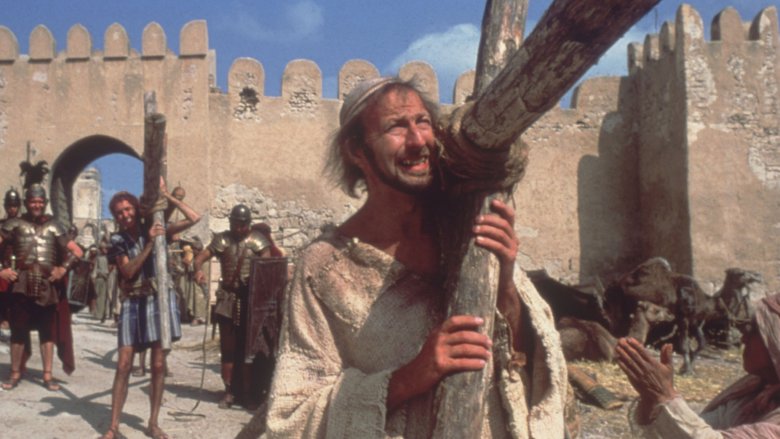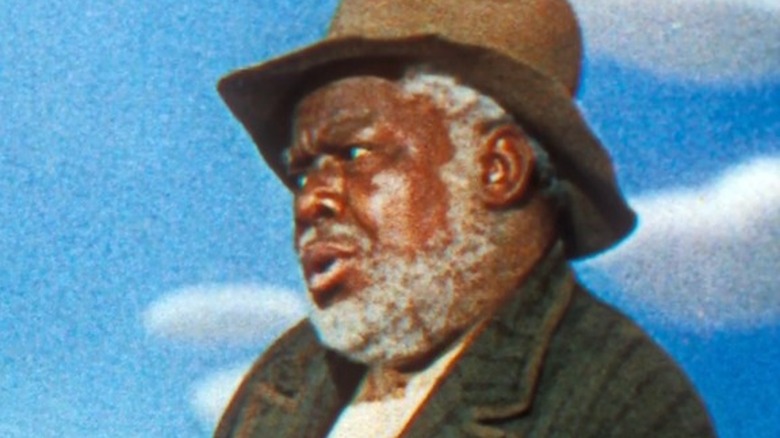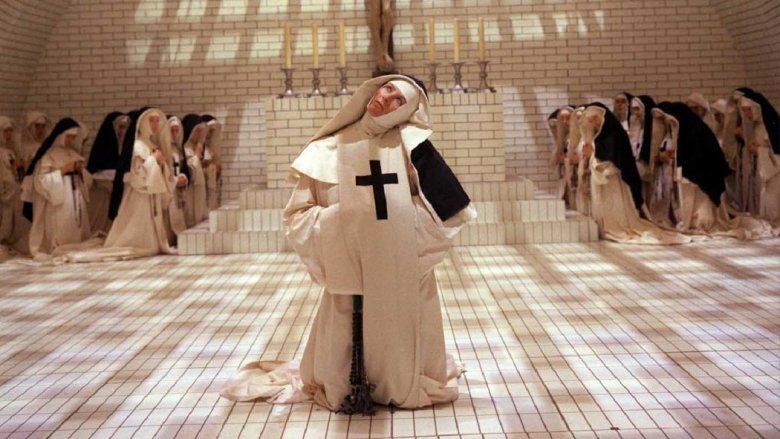The Most Controversial Movies Of All Time
In the best cases, a dramatic movie can be the equivalent of a brass knuckles punch to the collective jaw of society. The sheer size, scale, and spectacle of the big screen can create cultural zeitgeists overnight, transforming the world, spreading better understanding, or causing new debates. Film is inherently one of the most powerful mediums out there, and many filmmakers have put it to great use.
On the other hand, blowouts aren't always a good thing. In some of the worst cases, a storm of controversy can be really bad. There are times when desperate producers have intentionally courted controversy just to spread awareness about a mediocre film. There are also times when a production team thinks it's skating on the edge, only to go tumbling into a black hole of protests and picket lines. These films caused widespread rage, panic, and hostility for one reason or another — even though some of them have the depth of a teaspoon. Fasten your seat belt.
Cannibal Holocaust (1980)
There are plenty of gory movies out there. For proof, just pop in any Saw DVD. What made Cannibal Holocaust so particularly contentious was that some of the violence was real, and even the fake violence looked so real that director Ruggero Deodato was sent to court on accusations of actual murder. Deodato successfully cleared those homicide charges by coming to the stand with one of the supposedly "murdered" actors he was on trial for, but the controversies hardly ended there.
The Guardian called Cannibal Holocaust "the most controversial movie ever made" for a reason. Decades before the found-footage genre took off, Cannibal Holocaust ostensibly depicted itself as being footage recovered from a crew of American filmmakers who'd trekked into the Amazon wilderness and encountered "savage" tribes. This meeting results in scenes of torture, murder, rape, castration, and — of course — cannibalism, combined with an undeniably racist, exploitative portrayal of indigenous people.
On top of that, the film production engaged in real-life animal cruelty and kept the cameras rolling. The director has claimed that all the animals killed on film were only killed for food, according to the book The Pleasure and Pain of Cult Horror Films, but the actual film contradicts Deodato's justification, considering that it contains gruesome sequences like a turtle being completely dismembered and a muskrat being gutted alive. According to The Guardian, while the director dodged any charges of human murder, he did get fined for all the animal cruelty.
Birth of a Nation (1915)
This movie is here because ... well, duh. D.W. Griffith's Birth of a Nation is blatant racist propaganda of the absolute worst kind. It's bad enough that it was ever released, and even worse that President Woodrow Wilson was so enamored of the film's overt white supremacy that he screened it in the White House, according to PBS.
This 1915 film depicts a skewed history of U.S. racial struggles. It portrays the Ku Klux Klan as hooded heroes, combined with some of the most offensive caricatures of African Americans to ever appear in film history. According to History, the NAACP tried to get Birth of a Nation banned. The movie's release led to riots. Unfortunately, this racist blockbuster smashed records across the nation, and according to the New Yorker, the movie's success perpetuated the systemic racism that prevented aspiring black filmmakers from bringing the true story of American racism to a wider audience. Thanks to Birth of a Nation's impact on the cinematic landscape, important movies like Oscar Micheaux's 1920 feature Within Our Gates were nearly wiped from the history books.
One of the most hideous aspects of Birth of a Nation's success is that it literally revived the long-defunct Klu Klux Klan, according to History. Before the movie's release, the KKK had been crushed since the 1870s, but Griffith's film sparked a KKK resurgence, and by 1924, the Klan had three million members. So yes, maybe filmmakers should be careful, because movies can have a big impact on society.
Last House on the Left (1972)
Wes Craven's name tends to conjure up images of that scary guy with the blades for fingers. No, not Edward Scissorhands, the other guy. However, years before Craven reshaped the horror genre in his vision, he started his directing career with a dark, dirty, uncomfortable movie called Last House on the Left.
The movie follows a gang of psychotic killers who brutally rape and murder two teenage girls, then seek refuge in a house that happens to belong to the parents of one of their victims. Last House's graphic rape sequences were controversial enough, but when combined with an uneven tone that included a bizarrely campy sheriff, the movie got some seriously negative press. The British Board of Film Classification rejected the film, stating that "we can find no redeeming merit ... which would lead us to feel that this muddly (sic) film is worth salvaging." The BBFC labeled Last House on the Left a "video nasty," meaning that all copies of any VHS tapes within England were to be seized by the police. The movie was only reclassified in 2008. One of the film's actors, Fred Lincoln, stated that he wished the film was banned internationally, rather than just in the U.K..
This low-budget movie, produced for only $90,000, quickly gained such an unsavory reputation that conspiracy theorists debated whether it had been funded by either the Mob or adult filmmakers, according to the New York Times.
Natural Born Killers (1994)
Oliver Stone is no stranger to controversy, but his 1994 film Natural Born Killers was like a lightning rod for it. Natural Born Killers tells the "romantic" story of two serial killers in love whose psychopathic romance gets insanely glorified by the media. Considering that premise, it's not such a big surprise that Natural Born Killers received an outpouring of negative attention, which got Stone's movie swiftly banned in Ireland, as reported by the New York Times. Nonetheless, the movie struck a big profit of $50 million, according to Box Office Mojo. That's when the real problems started.
Basically, the case has been argued that the way Natural Born Killers presents its murderous protagonists has inspired a number copycat killings. According to the Guardian, there were at least eight brutal murders that occurred between 1994 and 2002 where the killers directly cited Natural Born Killers as their inspiration. A woman was paralyzed from the neck down in one of these copycat attacks, and her lawyers mounted a media-heavy lawsuit against both Oliver Stone and Time Warner, with lawyers claiming that the film's producers released the movie knowing it could inspire people to commit similar crimes.
After a lot of press, money, and controversy, the lawsuit was shut down in 2001. For his part, Stone has said he's still shaken by the whole thing, claiming that everything that actually mattered about his movie and the concepts he attempted to explore in it were "overlooked."
A Serbian Film (2010)
If you've heard of this movie, you probably already know a number of reasons not to watch it. Without going into too much detail, A Serbian Film depicts some extremely disturbing, extremely questionable sequences that probably should never have been featured in a movie. We'll leave it at that. Not surprisingly, censorship boards around the planet have gone to great lengths to restrict A Serbian Film's potential viewership, according to Rolling Stone. This 2010 film has been banned in such countries as Norway, New Zealand, Brazil, and Spain. When Netflix decided to remove the movie from its website and mailing service, the company didn't even bother to explain why, because everyone already knew.
A Serbian Film, which tells the story of a retired porn actor being sucked into filming one final, horrific adult movie, was also pulled out of a Frightfest screening in London. According to the Independent, there is some debate about whether the film might be intended as a dark allegory of the Balkan Wars of the 1990s or as an examination of Serbia's current place in the world. However, all the controversy surrounding the movie stems entirely from its obscene imagery.
The Last Temptation of Christ (1988)
Biblical movies are never more than a few inches away from the cliffs of controversy, but this movie stirred up a reaction like no other, as did the 1955 novel it's based on. At first, The Last Temptation of Christ doesn't sound like a movie that would cause such a ruckus: It pulled in an Academy Award nomination for director Martin Scorsese, who is Catholic, with a script by Calvinist Paul Schrader. However, the movie's depiction of Jesus Christ, as played by Willem Dafoe, is quite unconventional. Dafoe's Jesus is weary, rundown, and tormented by self-doubt over his impending sacrifice. This is already an unusual take, but what got people really angry is what occurs after Jesus is nailed to the cross.
On the cross, the movie's Jesus experiences a sort of "dream sequence," wherein he's tempted to climb down, get married to Mary Magdalene, have kids, and live an ordinary life. Jesus overcomes this "last temptation" by accepting his role as God's son.
According to PBS, the film was condemned before it was even finished, its production igniting campaigns, physical protests, and petitions. Evangelist Bill Bright publicly offered to pay off the studio in exchange for handing over all prints of the film. In 1988, a Paris theater showing The Last Temptation of Christ was set on fire, putting 13 people in the hospital, according to the New York Times. This particular action was denounced by the Archbishop of Paris, Cardinal Lustiger, who spoke out against the film but condemned the violent arsonists for behaving as "enemies of Christ."
The Human Centipede II (Full Sequence) (2011)
We all remember back when the first Human Centipede came out, even if we wish we didn't. Once the world realized that the "centipede" in the title wasn't some monstrous man/arthropod hybrid that was going to climb skyscrapers and battle tanks a la King Kong — but rather, that this title creature was actually a mad scientist's rather disgusting idea of how to spread one digestive system between three people — the movie kicked up a flurry of controversy. However, upon its release, the actual Human Centipede movie turned out to be a surprisingly conventional B-horror movie, albeit one more gruesome than the norm.
Not so with its far more graphic sequel, titled The Human Centipede II (Full Sequence). This movie features a "fan boy" of the original film being so inspired that he creates a homemade copycat centipede of his own, using staple guns, duct tape, and barbed wire. The BBFC argued that the grotesqueness of these sequences, combined with the completely unsympathetic portrayal of the victims, were not fit for public consumption, and effectively banned the movie in 2011, according to the Guardian. It met a similar fate with the censorship boards of Australia, as written by the New York Times, as one spokesperson even referred to the movie as "pornography based on human torture."
The movie was followed with Human Centipede III, a film that upped the violence and sexism from its predecessor but dropped off the radar much more quickly.
Life of Brian (1979)
The Last Temptation of Christ was one thing, but Monty Python's 1979 comedy Life of Brian was a whole other can of worms. For anyone who hasn't seen or heard of it, Life of Brian is a satirical take on the life of Christ, introducing the world to Brian of Nazareth, a regular guy who happened to be born on Christmas. Brian then ends up with the bad luck of being named as the Messiah and is eventually crucified by the Romans.
Playing the Jesus story for laughs stirred up a tornado of controversy, as told by the Telegraph. Theaters showing Life of Brian were picketed, the Monty Python film was banned in Norway, and the whole enterprise was condemned by the Catholic Church. The BBC even aired a television debate pitting two Monty Python members, John Cleese and Michael Palin, against the Bishop of Southwark and religious spokesman Malcolm Muggeridge. Meanwhile, according to the Guardian, an assortment of major religious groups, including the Catholic archdiocese of New York and the Union of Orthodox Rabbis, publicly spoke out against the film, with many calling it blasphemous. Despite all this controversy, Life of Brian ended up being an enormous box office success.
Song of the South (1946)
Everyone knows Disney's famous "Zip-A-Dee-Doo-Dah" song by heart. Even if you despise the tune, you can't avoid it. This popular little melody is practically a symbol of Disneyland. However, even if you know the song, you've probably never seen the movie it originally came from. That's because the film in question, titled Song of the South, has been locked away in Disney's forbidden vault for almost three decades.
Why? Because Song of the South is an insanely racist movie that perpetuates the same Southern slave stereotypes as Birth of a Nation, with black characters like Uncle Remus being portrayed as jolly, happy-go-lucky folk who cheerfully serve their white oppressors. This romanticized, cozy remaking of the slavery's dark history has only become more shameful with time, but it's nothing new. As told by the Guardian, Frederick Douglass was speaking out against this kind of crap all the way back in the 1800s: namely, the all-too-common racist allegation that hearing a slave singing was "evidence of their contentment." So yeah, Disney really didn't have any excuse to be spouting the same nonsense a century later.
Song of the South is so fundamentally racist that Disney has tried to burrow the film out of the world's collective memory. According to Slate, the primary residual traces that remain are that famous tune, and the strange fact that many of the characters have survived as part of the Splash Mountain ride.
The Devils (1971)
Though most of the films on this list have had constant reputations since their initial releases, Ken Russell's The Devils is something of an exception. Though The Devils engendered a massive controversial backlash when it first came out in 1971, the studio-driven hacking and slashing that the film went through caused it to mostly disappear off the radar ... until a recent cult revival.
The Devils is loosely based on the true story of Urbain Grandier, an unconventional Catholic priest who was burned at the stake under accusations of witchcraft in the 1600s. Russell's fusion of religious iconography with graphic sexuality set off a volcano of anger, according to The Wrap, with thundering protests greeting The Devils' release. Desperate to calm the reaction, the studio ordered countless cuts to the already expensive movie, slicing out so many key sequences that few people today have ever seen the original cut. However, various versions of the film have survived, going on to inspire contemporary filmmakers like Guillermo Del Toro and Joe Dante.
The movie itself features many visuals that would still be controversial today, according to IndieWire, with such sequences as a nun orgy, holy water enemas being used as a form of exorcism, and a masturbation sequence involving a dead character's tibia bone.
